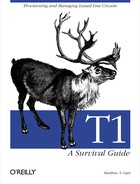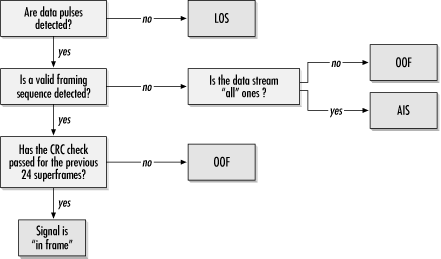Failures are the highest-priority events because they indicate drastic problems. Most failures are simply extended presences of the associated defect. The only exception is that so-called path failures (frame loss and alarm indication), which are associated with the logical data path between endpoints, have mutually exclusive signaling and only one can be declared at any point. Here is a list of failures, the conditions of which are detailed in Table C-2:
- Loss of signal (LOS) failure
Signal loss is the most basic failure. Signal loss initially triggers the LOS defect. If the defect persists, failure is declared. LOS failure is cleared when a signal with an appropriate ones density is received at the network interface. The time to clear the failure depends on the equipment. Generally, it is only a few seconds, though it is permitted to be as many as 20.
- Loss of frame (LOF) failure
Signal loss corresponds to the most basic transmission on a T1. Performing the T1 framing appropriately is one step up from moving electrons from one end to the other. If either aspect breaks down, the line will fail.
LOF failure is declared when the out of frame (OOF) condition persists. (OOF is described later in this appendix.) Like the signal loss alarm, it may take up to 20 seconds to clear the LOF failure.
LOF is not declared when the alarm indication signal (AIS) is present. AIS is a higher-priority alarm, and the signaling bits must be used for only one of the two.
- Alarm indication signal (AIS) failure
A persistent AIS defect causes AIS failure to be declared. Because AIS has a higher priority than LOF, AIS can be declared immediately if no framing signal is detected. Like the two previous signals, it may take up to 20 seconds to clear an AIS failure.
When many devices are placed in the loopback mode, the data is looped back toward its source and the AIS signal is sent on in place of the data to alert equipment further along the path that a device along the way is in loopback mode. This is a configurable option that is frequently activated on smart jacks.
If you determine that neither of the CSU/DSUs at the end locations are in loopback mode, ask the carrier to trace the source of the AIS signal for you. If it is a piece of equipment along the signal path, the carrier can usually deactivate the loopback by using a network maintenance command.
- Remote alarm indication (RAI) failure
When the incoming link on a T1 fails, the CSU/DSU transmits a code in the outbound direction to inform the other end that the link has failed. RAI was previously referred to as the yellow alarm, and some documents refer to it as the far end alarm. RAI is declared when an incoming RAI signal is detected, and it is cleared when the RAI signal is no longer received.
Table C-2. T1 failure conditions
|
Failure |
Declaration condition |
Clearance condition |
T1.231 reference |
|---|---|---|---|
|
2-3 continuous seconds with LOS defect |
At most, 20 continuous LOS-free seconds[a] |
6.2.1.1.1 | |
|
2-3 continuous seconds; or OOF defect (except when AIS present) |
At most, 20 continuous OOF-free seconds; or AIS failure declared (priority rule) |
6.2.1.2.1 | |
|
2-3 continuous seconds AIS defect; or AIS defect when LOF is declared |
At most, 20 continuous AIS defect free seconds |
6.2.1.2.2 | |
|
Detection of RAI signal |
No RAI signal detected |
6.2.2.2.1 | |
|
RAI (send) |
LOS, LOF, or AIS failure declared; transmitted for a minimum of 1 second |
Immediately on clearing of underlying failure[b] |
6.4.1 |
[a] Typically, an alarm is cleared in much faster than 20 seconds. Some equipment, however, incorporates legacy functions and may take up to 20 seconds to clear an alarm. [b] RAI is sent as long as the underlying cause persists. If the underlying causal alarm is subject to a 20-second waiting period, RAI persists throughout the waiting period. | |||
With alarms stacked in priority and some being mutually exclusive, it is worth considering how equipment typically determines whether an alarm should be declared. Figure C-4 shows the logic a T1 receiver typically uses on an ESF link. When pulses are detected on the line but no framing sequence is detected, if the content is substantially all ones, AIS is declared. Otherwise, the OOF or LOF alarm will be declared. To prevent noisy lines from corrupting a great deal of user data, the terminating equipment typically requires that the CRC check pass for 24 superframes before declaring that the signal is in frame.
Defects alert administrators to potential performance issues. Defects may grow into full-blown failures. Unlike path failures, path defects are not mutually exclusive and can be declared simultaneously. Here is a list:
- Loss of signal (LOS) defect
When a period of 100 to 250 unit intervals (bit times) has passed with no pulses, the LOS defect is declared. This defect is cleared when a comparable time interval has passed with the incoming signal meeting the pulse density requirements. Generally, this is taken to mean a comparable interval with a pulse density of at least 12.5%.
- Out of frame (OOF) defect
Both the superframe (SF) format and the extend superframe (ESF) format incorporate framing bits. Incorrect framing bits are called frame bit errors. A single frame bit error is not enough to declare an out of frame condition. Most equipment uses an n out of m density requirement, where n framing bits out of m consecutive framing bits must be in error to lose the framing. Typical values lead to an error density requirement of between 40-60% frame bit errors over short periods of time. See Table C-3 for details. OOF is terminated when the signal is reframed, which requires a sequence of m clean frame bits.
As a practical matter, most ESF equipment avoids clearing the OOF condition until the CRC is good for several superframes. Typically, 24 error-free superframes are required, but this number is not specified in any standard.
AIS signals cause an OOF defect because AIS is an unframed, all-ones signal. However, the AIS defect triggers an AIS alarm, which overrides the LOF alarm.
- Severely errored framing (SEF) defect
Signals that are drastically out of frame lead to a severely errored framing defect. Terminating equipment maintains a monitoring window for frame bits. Two frame bit errors in the window cause a severely errored framing defect to be declared. On SF-framed links, the window is 0.75 ms and only the terminating frame (Ft) bits are examined. ESF-framed links use a 3-ms window and examine only the ESF frame synchronization bits.
Out of frame signals almost always cause a severely errored framing defect. For clarity, the rest of this appendix uses “out of frame” where “severely errored framing defect” is used in the specification. The two nearly always go hand-in-hand, and I find “out of frame” to be a more descriptive term.
- Alarm indication signal (AIS) defect
When an unframed all-ones signal is received for an interval between 3 and 75 ms, the AIS defect is declared.[35] It is cleared after the same interval.
Because an AIS signal is unframed, it leads to an out of frame defect as well as severely errored framing.
Table C-3. T1 defect conditions
[35] Customer-side AIS signals are not all ones. Technically, this requirement is the reception of a signal that has a ones density of 99.9%.

